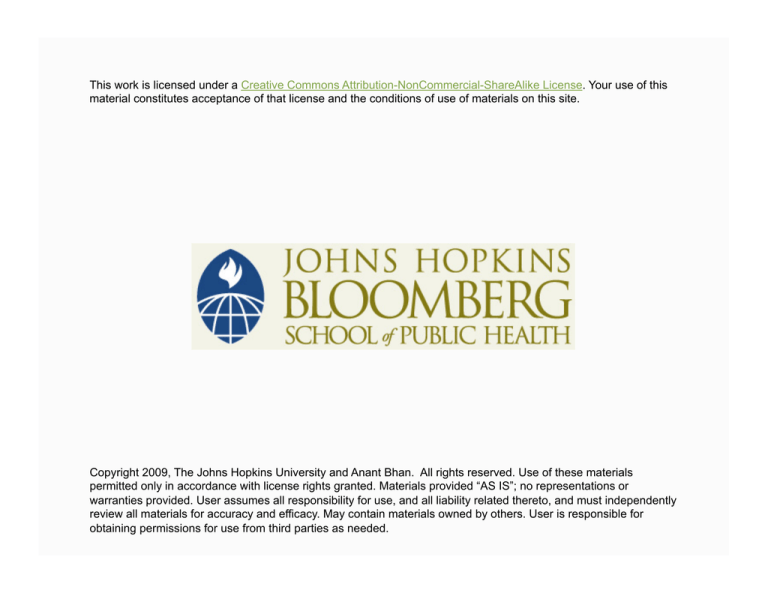
This work is licensed under a Creative Commons Attribution-NonCommercial-ShareAlike License. Your use of this
material constitutes acceptance of that license and the conditions of use of materials on this site.
Copyright 2009, The Johns Hopkins University and Anant Bhan. All rights reserved. Use of these materials
permitted only in accordance with license rights granted. Materials provided “AS IS”; no representations or
warranties provided. User assumes all responsibility for use, and all liability related thereto, and must independently
review all materials for accuracy and efficacy. May contain materials owned by others. User is responsible for
obtaining permissions for use from third parties as needed.
Section C
Challenges in Maintaining Privacy in Our Settings;
Mechanisms to Address Challenges to Privacy and
Confidentiality
Inequity: Power Hierarchies
Source: Picture courtesy of Dr. S.P. Kalantri.
3
Lower Levels of Literacy and High Levels of Trust in Health Care Providers
Source: Picture courtesy of Dr. S.P. Kalantri.
4
Overcrowding: Lack of Space, Especially in the Public Sector
Source: Picture courtesy of Dr. S.P. Kalantri.
5
Challenges to Maintaining Privacy in Developing Country Settings
In biomedical research: in overcrowded hospital settings,
overworked medical personnel undertake research
-
-
-
-
One needs to provide for space and time for informed consent
One needs to maintain privacy for procedures that keep the
dignity of the participant
One needs to address issues of privacy with respect to
compliance, follow up procedures if any
Issues relating to medical hierarchies and power structures in
health care delivery system
6
Mechanisms to Overcome These Challenges to Privacy
Biomedical context:
- Treat the research context as different from the treatment
context
-
-
-
-
Create space and time for a meaningful dialogue with
participants
Seek institutional and funding support
Train all the researchers in these requirements
Use IEC review as an empowering process
7
Challenges to Maintaining Confidentiality in Developing Country Settings
In biomedical research:
-
Using of patient records due to the overlap in the researcher role
and the health provider role
-
Medical records have universal access through out the particular
system
Lack of a culture of ethical review and the need to maintain
confidentiality
-
8
Mechanisms to Overcome these Challenges to Confidentiality
Delink research data from usual access through the health system
Alternative storage mechanisms
If electronic data, make sure access is restricted by use of codes,
passwords
Delink the data on a computer from network access
Limit the number of people who have access to the data
9
Mechanisms to Overcome these Challenges to Confidentiality
Anonymise data
Pseudonymised data
Encrypted data
10
Mechanisms to Overcome these Challenges to Confidentiality
What do we mean by anonymise data?
- This means removing the information in the data that would
help to identify the person uniquely
-
This does not mean just name and address, it could mean
remove names of villages in some contexts, removing names of
the other diseases that the person has, or any other information
that could be used to identify the person
-
Consult other researchers who have worked in the field on
similar studies and IEC members
11
Mechanisms to Overcome these Challenges to Confidentiality
What is pseudonymised data?
- Describe the issue by using a nickname for the person or
institution etc.
What is encrypted data?
- Use alternative codes for persons’ unique identifiers in such a
way that only those who are part of the research process can
actually de-code and work with
12
Mechanisms to Overcome these Challenges to Confidentiality
Prevention methods
- Only collect data that you will use
-
If you do not need some information that can be used to
identify the individual, do not collect such information
-
Store the identifiers separately, if you collect them
13
Do We Always Have to Respect Privacy and Confidentiality?
Not if the event or study is based on public events, such as the
behavior of persons in the carnival/mela
Not if it involves data already in the public domain
Not if it does not have the potential to identify or harm any of the
participants
These studies still need to be cleared by the IEC, you alone cannot
judge these matters!
14
Summary
Privacy and confidentiality; distinction
Why these are important/what the guidelines say
Situations in research context where care needs to be exercised
Practical suggestions in a research setting
15
References
Cross, Susan & Sim, Julius. (2000). Confidentiality within
physiotherapy: Perceptions and attitudes of clinical practitioners,
Journal of Medical Ethics, 26, pp. 447-453.
Khan, Murad. (2003). Confidentiality in research. Presentation made
at the workshop on ethical issues in health research, Aga Khan
University, Karachi.
O’Brien, J. & Chantler, C. (2003). Confidentiality and the duties of
care. Journal of Medical Ethics, 29, pp. 36-40.
Ethical guidelines for social science research in health, NCESSRH,
CEHAT, Mumbai. (2000).
ICMR. (2006). Ethical guidelines for biomedical research on human
subjects. New Delhi.
16
Acknowledgement and Thank You
Presentation adapted from a presentation on this issue by Dr. Mala
Ramanathan, AMCHSS, Trivandrum
17







